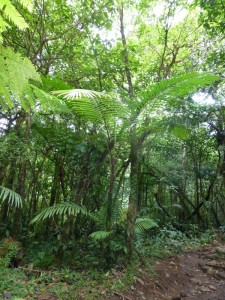Day Four
On Thursday, we decided to head up to Volcano Tenorio and Catarata de Rio Celeste. It should have been maybe a two hour journey from where we have been staying, but because of a few bad calls, was over three. And we finally saw the unpaved roads I had expected to see much more in Costa Rica. Because of Dave’s superior driving skills, we survived unscathed and saw some really amazing country side, unfortunately the only picture I was able to capture was this one of a cemetery above ground:

The first above ground cemetery we saw was on our way to the Osori Valley at Trio Rios. That little town was around three rivers and so I assumed the above ground cemetery was to keep everything dry, like in New Orleans. But this little cemetery is up in the mountains. Anyway, traditions are traditions.
Our travels took us past all kinds of fauna that was fenced (cattle, etc) and extremely interesting flora I was unable to get photo’s of. Of the three plants I want to highlight is the way Costa Ricans use live trees/shrubs as fencing. They plant trees/shrubs along a line they want fenced and then attach barbed wire to it. Something that’s cool about this, besides being renewable, is you can “add posts” anytime and let them grow in. And you don’t need to buy fence posts and a post hole digger, just plant a new plant on occasion. (Picture to come).
The other flora I really want a picture of is this round tree that seems to grow in three distinct tiers. These trees have these over-sized leaves arranged in the three tiers that are maybe two feet tall, about fifteen feet across and about three feet between tier. (Picture to come).
One of the floras you see a lot here are tree ferns (not the ferns growing in trees), but ferns that actually have a trunk and grow as a tree. This is one of the floras I actually got a picture of:

So we made it to Volcan Tenorio and it is one of the least used national parks and I guess one of the reasons is the difficulty in climbing up the steep boulder strewn dirt road. On the way up, we came across a flock of Montezuma birds. You see these birds all over and besides their colorful feathers, they have this very melodic chirping and then encore when they’re chatting:

The flocks build a whole series of hanging baskets as a colony:

So we arrived at Volcano Tenorio National Park, registered with the rangers and took off up the trail towards Catarata de Rio Celeste. The Rio Celeste is famous for its azul colored waters, 30 meter waterfall and colorful pools. To get to the catarata (waterfalls), it’s about a kilometer up the trail through a rain forest. It’s not one of those rainforests with wild macaws, etc flitting all over the place, but definitely worth the adventure. Besides all the lush flora not found north of Florida, there’s also all kinds of striking growth like these roots that are very common throughout the trek:

Once you travel the kilometer up the trail, you need to decent six zillion steps to see the waterfall. Here’s a picture of the waterfall:

It’s actually six zillion steps; I counted them on my way back up: 🙂

The reason the water is so blue is from the volcanic activity below. This first picture is where some water is literally bubbling up from the volcano below (with a very strong sulfur smell):

This picture you can see the actual fissure where the blue water is coming out with the clear water above in the stream:

Here’s a picture of a heliconia (commonly called lobster claws for obvious reasons) we passed in the forest. I love these flowers; I tried several times to grow them when living in South Florida without success. I know they are native to Hawaii, but don’t know if they are indigenous elsewhere (like Costa Rica):

Finally, this picture shows cloud shrouded Volcano Tenorio on our way home:

I think that’s about it for today, have a great one, I am,
ed



